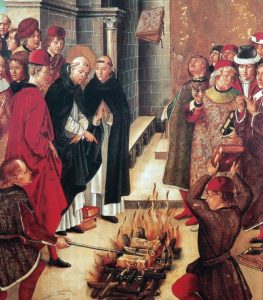When the Talmud Was Burned
 How was it that you, O Law, given by G-d, the Consuming Fire,
How was it that you, O Law, given by G-d, the Consuming Fire,
Should be consumed by the fire of mortals,
And that the heathens weren’t singed by your burning coals?
How can food ever again be sweet to my palate
After beholding what your plunderers have gathered?
Men whom you rejected from entering your assembly
Burned the spoil of the Most High in the midst of the market
square,
Like the possessions of a condemned city.
(Adapted from a translation by A. Rosenfeld)
With these poignant words from the kinah “Sha’ali Serufah Va’eish,” recited by Ashkenazim each year on Tishah B’Av, Rav Meir of Rothenberg (1215-1293) mourned the burning of the Talmud in Paris that he had witnessed in June of 1242. He writes that he himself saw 24 wagon loads of Talmudic volumes destroyed. This horrible anti-Semitic act had enormous consequences for the study of the Gemara in Ashkenaz (France and Germany) in the Middle Ages. In fact, we have only one complete manuscript of the Talmud Bavli, the Munich manuscript, an Ashkenazic copy from 1342.
But the burning of the Talmud in Paris was not a sudden, isolated event. Rather, it capped a long history of anti-Semitic accusations. While the European Jewish communities had their origins in the Roman period, it wasn’t until the Middle Ages that they emerged as major centers of Jewish life. By the time these communities attained developed status, during the 10th-11th centuries, the text of the Gemara had reached a more or less fixed form, even if it circulated in varying manuscript traditions. The authority of the Bavli over the Yerushalmi had been accepted already under the Geonim (7th to 11th centuries). But it would not be long before it, like the community that lived according to its principles, would come under attack from anti-Semites.

Just a footnote to the picture accompanying this excellent article. The painting is offered as a representation of the burning of the Talmud, the subject of the article, but in no way does this painting refer to a burning of the Talmud or any other Jewish books. The first clue is that the fire portrayed in this painting is the size of a small campfire. The Paris Jewish book burning, estimated at some 10,000 manuscript volumes of Talmud, was a massive bonfire. Second clue is that there are no “funny” costumes in this painting, only normal garments. Jews throughout the Middle Ages were required to wear clothing that distinctly identified them as Jews to the general population. In 13th century Paris, for example, Jewish men were required to wear pointed hats by royal decree.
In fact, the painting here portrays the story of a dispute between Saint Dominic and the Cathars in which the books of both were thrown on a fire, and St. Dominic’s books were miraculously preserved from the flames. This was believed to symbolize the wrongness of the Cathars’ teachings. The painting hangs in the Prado Museum and is thought to have been painted in the 1490’s.